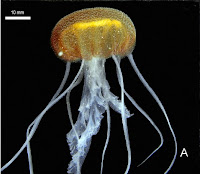Farmed Salmon are raised within caged enclosures in marine embayments, spending their entire lives within a limited area, unlike wild Salmon which roam over vast areas during their life-cycles, spending parts of their lives in marine environments and parts in freshwater. This makes farmed Salmon vulnerable to a variety of environmental threats that wild Salmon are able to avoid. One such threat is damage by Jellyfish swarms, which drift in vast numbers on the ocean currents, and which can cause significant damage when they encounter farmed Salmon, with smaller Jellyfish able to pass through cage meshes directly and adult specimens being broken up by the meshes, killing the Jellyfish but creating body fragments with still active stinging cells which could enter the cages. In one notorious case in 2007 a swarn of Mauve Stinger Jellyfish, Pelagia noctiluca, wiped out the entire stock of a Salmon farm in Northern Ireland, about 250 000 Fish.
In a paper published in the Journal of Fish Disease in January 2016, Mar Marcos-L opez, Susie Mitchell and Hamish Roger of Vet-Aqua International in Oranmore, County Galway, Ireland, descibe the results of a study of Jellyfish damage to farmed Salmon on the West Coast of Ireland in 2013.
The most abundant swarming Jellyfish seen on thw West Coast during the study peroid was the Mauve Stinger, however unidentified species of Phialella and Muggiaea were also recorded. Mauve Stingers are an entirely free-living species, unlike many Jellyfish which have a bottom-dwelling atteched polyp stage, enabling swarms drifting on ocean currents to continuously add to their own numbers (species with an attached polyp stage typically swarm for a season, then produce an overwintering polyp stage). They are found in vast numbers in all warm and temperate seas and oceans, though in seasonal climates they do die off in winter, so the biggest swarms are found in autumn and late summer, when seasonal storms often push them onto shores.
In 2013 Mauve Stingers swarms were reported at Salmon farms from August to November on the West Coast of both Northern Ireland and the Republic of Ireland, resulting in mortality rates among caged Salmon of up to 70%. Examination of both dead and live Salmon revealed numerous skin lessons, with Fish sufferning from respiratory distress (a syptom of Jellyfish venom), loss of apatite, apathy and increased jumping.
Numerous Pelagia noctiluca jellyfish inside marine Atlantic Salmon pen. Pete McDonagh in Marcos-L opez et al. (2016).
Many of the lessons caused by Jellyfish stings were found to be infected with a filamentous Bacterium, Tenacibaculum sp., which appeared to colonize necrotic Jellyfish filaments; these Bacteria are known to be carried by living Jellyfish, suggesting the infection was brought with the swarm, and was not just an opportunistic action by an organism living free in the water. The Salmon farmers responded to these infections by raising the levels of anti-biotics administered to the Fish.
See also...
 A new species of Jellyfish from the North Adriatic Sea.
While instantly familiar and biologically simple, Jellyfish (Scyphozoa)
are still in many ways poorly understood, with frequently poorly
understood life-cycles and population structures, leading to unexpected
shifts in population and sudden blooms of large numbers of Jellyfish,
which can impact on commercial...
A new species of Jellyfish from the North Adriatic Sea.
While instantly familiar and biologically simple, Jellyfish (Scyphozoa)
are still in many ways poorly understood, with frequently poorly
understood life-cycles and population structures, leading to unexpected
shifts in population and sudden blooms of large numbers of Jellyfish,
which can impact on commercial... Jellyfish force closure of Swedish nuclear power plant.
The Oskarshamn Nuclear Power Plant in Kalmar County on Sweden's
southeast coast was forced to...
Jellyfish force closure of Swedish nuclear power plant.
The Oskarshamn Nuclear Power Plant in Kalmar County on Sweden's
southeast coast was forced to... The mysterious ebb and flow of Jellyfish populations.
Many scientists and conservationists are worried about the state of the
world's oceans. Many important marine ecosystems are known to be under
stress: once prolific fisheries have collapsed; dead
The mysterious ebb and flow of Jellyfish populations.
Many scientists and conservationists are worried about the state of the
world's oceans. Many important marine ecosystems are known to be under
stress: once prolific fisheries have collapsed; dead
Follow Sciency Thoughts on Facebook.

